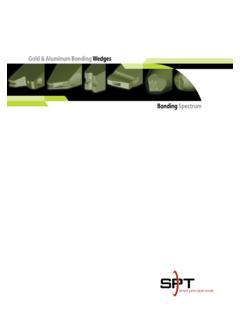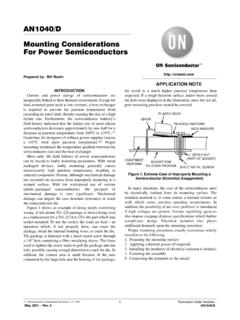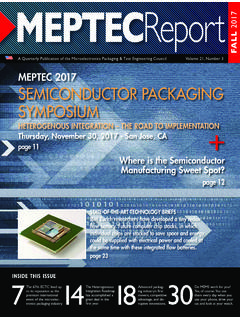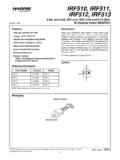Transcription of TI's journey to high-volume copper wire bonding …
1 TI s journey to high-volume copper wire bonding productionUsman ChaudhryWire bond packaging manager,SC PackagingTexas InstrumentsAmit NangiaPackaging reliability manager,SC PackagingTexas InstrumentsTI s journey to high-volume copper wire bonding production 2 October 2014 The use of copper wire bonding in semiconductor packages has seen a steady evolution in recent years. The technology offers better performance and is more economical than traditional gold wire bonding , and Texas Instruments has played an instrumental role in developing copper wire bonding across the industry. With billions of units shipped, TI offers packaging solutions that deliver the performance, reliability, quality and cost advantages of copper . copper wire bonding is a proven, standard solution across many of TI s analog and embedded processing and it has gained broad acceptance among customers across a range of end markets, including high-reliability applications like industrial and automotive.
2 This white paper will explore the technology s benefits and technical challenges faced in the ramp of copper wire bonding to high volume reliability, quality and performance advantages to customers After years in which the semiconductor industry postponed the introduction of copper wire bonding between silicon die pads and package leads, copper wire bonding technology has finally gained traction as a mainstream IC assembly solution. In the past, chip manufacturers relied on gold wiring because it is easy to work with, but gold has performance limitations that make it less than ideal in some applications. In addition, manufacturers needed to find an alternative solution against the rising cost of gold to ensure a steady, more stable supply to high-volume copper might seem to be a natural fit for chip-to-package wiring because of its favorable cost, high electrical conductivity and other characteristics, in fact it presents a number of manufacturing challenges which hindered adoption.
3 But over the past decade, TI and other companies have dedicated development efforts and considerable quality and reliability testing in order to overcome these challenges. Today, copper wire bonding has come into its own as a proven solution for packaging, so much so that it has become standard for TI foresight drives developmentTI was one of the early leaders in developing and adopting copper wire bonding technology, and the first to introduce it into high-volume production. The company was well positioned to develop the technology because of its long-established TI s journey to high-volume copper wire bonding production 3 October 2014operations in chip assembly and test (A/T). With a history of building its own chip assembly equipment, TI was able to experiment with copper wire bonding independently to evaluate the results and benefits. TI s extensive relationships with A/T tool and materials suppliers also provided a conduit for valuable input in the development of next-generation equipment that could support copper .
4 TI s wide portfolio of analog and high-performance digital products, supported by manufacturing flexibility, enabled a careful phase-in strategy in A/T facilities worldwide. With an effort that spanned a decade of research, development, process qualification and continuous improvement in manufacturing techniques, TI has played a significant role in getting copper wire bonding technology up and running across the of copperCopper has normally been the metal of first choice for the wires used for power and communications, where it provides excellent conductivity, durability and ductility, at an economic cost. copper has also been used in recent years for the interconnections between the transistors on integrated circuits. However, for the ultra-fine, thin pitch wiring that connects an integrated circuit s die pads with its package leads, chip makers have traditionally used gold because it is easy to work with in manufacturing.
5 Gold is relatively soft, non-reactive except with aluminum, and offers sufficient electrical conductivity for many applications, though less than , high electrical performance depends on ex-cellent conductivity or, in other words, low resistance. Since copper has less electrical resistance than gold, (Figure 1), its conductivity is up to 40 percent higher which translates into important performance benefits for customers. As a result, copper can provide signifi-cant advantages in high-performance communications, computing, industrial equipment and other s improved thermal conductivity means that it is better at pulling heat away from the die, leading to better performance at elevated temperatures and greater reliability. This performance advantage is par-ticularly evident when copper wire is bonded on die pads plated with thick copper and nickel palladium finish in analog ad power product where support for high currents is essential.
6 In this case, the metal joint formed is a solid-solution weld that is extremely stable at high temperatures. In addition, the metal s hardness means that bonds stay more stable mechanically in stressed operating environments. Overall, copper wire bonding is technically more challenging than gold, but once achieved, the wiring is more resilient and performs better, especially in high-current analog products such as power the technical challengesDespite the cost, performance, quality and reliability benefits, there were many technical challenges in developing copper as the best choice for chip-to-package thin wiring. One of the most important Figure 1. Conductivity and resistance differences between gold and copper conductivity (mho-cm) at 25 CDC resistance of single wire (m ) (2mm length, um diameter)Thermal conductivity (W/mK) at + ~ +0576~ 398TI s journey to high-volume copper wire bonding production 4 October 2014technical issues had to do with copper s hardness and brittleness relative to gold.
7 copper wires must be handled very carefully in order to eliminate the risk of damaging bond pads and underlying circuitry. As a result, new-generation wire bonders are designed to bond copper wires more precisely on circuit pads, with more finely tuned force, heat and ultrasound energy applied to create the bond. Modifications to the bonding wire capillaries were also introduced in order to make the wire adhere better to package pads and form a tighter bond. Another formidable challenge of using copper is its reactivity with oxygen in the surrounding air. wire bonders now provide an inert atmospheric envelope by means of a forming gas that surrounds the wire tip, thus preventing oxidation during bonding and enabling stronger bonds (Figure 2).The new bonding techniques for copper required careful development and thorough testing, with characterization under a variety of different manufacturing and environmental conditions, including those designed to be worse than anticipated in actual production.
8 The expertise was shared within the company and with suppliers in order to fan out successful discoveries and speed up technology development. In the meantime, TI worked closely with materials vendors and characterized materials extensively in order to maintain high standards for packaging quality, once copper wiring was in the process moved from development into manufacturing, success with different types of products did a great deal to drive the learning curve for assembly and testing the reliability of copper in various operating conditions. Analog power ICs, Overview copper wire bond processForming gasrequired6. 2nd bond: USG energy, force, time, scrub7. Clamp tears wire , leaving tail for 23. Free ball formation5. wire looping to lead nger4. 1st bond:Force, energy, heat, time1. wire feeds intocapillary from spool2. EFO SparkFigure 2. An overview of TI s copper wire bonding process, which uses forming gas s journey to high-volume copper wire bonding production 5 October 2014where copper wires are bonded to thick copper nickel palladium plated pads on the chip, require stable operation with high currents in order to provide a safe electrical environment for the device and the rest of the system.
9 On the other hand, wireless devices demand the assembly and operational specifications that are characteristic of high-volume digital products, including precise, secure bonding of copper wires to aluminum pads. Additionally, these product areas make use of various types of leaded packages and ball grid arrays, requiring accommodation of wiring techniques to different physical layouts. By mastering the challenges involved in copper wiring with these types of products, TI gained wide-ranging expertise that it continues to build upon and fan out to other products today. Evolution of a new wiring technologyThe change from gold to copper wire bonding is an example of adapting technology slowly and carefully in order to gain significant benefits. Because of the metals different characteristics, the transition was not a simple switch of materials, but a carefully monitored re-engineering effort.
10 Like every stage in IC manufacturing, the process of selecting, forming and bonding chip-to-package wires had to be extremely precise in order to provide the necessary quality and reliability in the shipped the copper wire bonding process required several years of preliminary studies and experiments, extensive testing and process qualification that customers can have confidence in today (Figure 3). By 2008, TI entered volume Figure 3. TI s copper wire bonding production Production ramp across TI 2006 2005 2008 2007 2009 Process Physics Initial Investigation Process Characterization Thick Cu Ni Pd Bond Pads Aluminum Bond Pads Leaded Packages BGA Packages Dev t/Process Qualification 2010 2014 Volume Began copper wire development and characterization TI s history with copper wire bonding Qualreleased1B units shipped22B units shippedTI s journey to high-volume copper wire bonding production 6 October 2014production of its first products using the technology.















